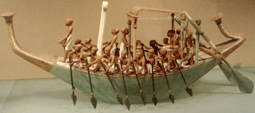TT280
Tomb TT280, located in Sheikh Abd el-Qurna, part of the Theban Necropolis, is the burial place of the Ancient Egyptian noble Meketre who was chancellor and chief steward during the reign of Mentuhotep II and Mentuhotep III, during the Middle Kingdom.[2]
| Theban tomb TT280 | |||
|---|---|---|---|
| Burial site of Meketre | |||
 Floorplan tomb TT280 | |||
| Location | Sheikh Abd el-Qurna, Theban Necropolis | ||
| |||
| Meketre in hieroglyphs |
|---|
Discovery and excavation

The tomb was discovered in 1895 by Daressy. It had been plundered in ancient times, but when Winlock excavated the tomb in 1920 an undisturbed room containing several models was discovered. [3] These models cover daily life at the estate of the Vizier Meketre.
Models
This tomb contained many models:
In the Cairo Museum: Two canoes with draw-net, Boat with paddles, and Meketre and son Antef under canopy, sailing-boat with Meketre under canopy, Kitchen tender, Sailing-boat with wicker cabin, Sailing-boat, house in garden, Carpenter's shop, Spinning and weaving, Inspection of cattle, Female offering-bringer with drink.[1]
In the Metropolitan Museum of Art, New York: Rowing-boat with musicians and kitchen tender, Rowing-boat, Sailing boat with Meketre and son Antef under canopy, Boat with paddles, Boat with paddles, men harpooning fish, and Meketre and son Antef seated on deck, Female offering-bringer with food, Four male and female offering bringers in procession, Cattle in stable, Slaughterhouse, Granary, Brewers and Bakers, House in garden.[1]
| Wikimedia Commons has media related to Tomb of Meketre. |
See also
References
- Porter and Moss, Topographical Bibliography: The Theban Necropolis, pg 47-49
- Roehrig, Catherine H. “Life along the Nile: Three Egyptians of Ancient Thebes.” The Metropolitan Museum of Art Bulletin, vol. 60, no. 1, 2002, pp. 1–56. JSTOR, www.jstor.org/stable/3258908.
- Spaull, C. H. S. The Journal of Egyptian Archaeology, vol. 42, 1956, pp. 124–125. JSTOR, www.jstor.org/stable/3855141.
External links
- Bibliography for TT 280: Meketre—Theban Mapping Project